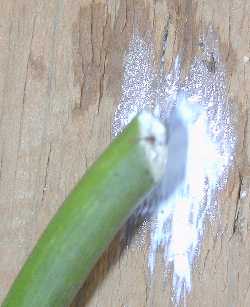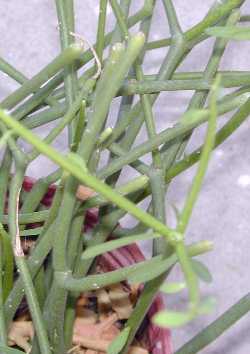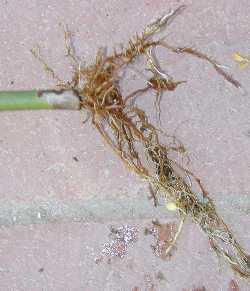by Philippe Faucon
|
|
The Pencil Euphorbia (Euphorbia tirucalli) is a common house plant, it is grown as a succulent shrub. The short-lived leaves drop rapidly and leave a mass of green similar-sized pencil looking stems. In zone 10, and in protected areas of the Phoenix areas, it can be grown directly in the soil, and after a few years, becomes a small tree. Pencil Euphorbias are grown very easily from cuttings, and these few pictures show what happens. As all the Euphorbias, Euphorbia tirucalli has toxic white latex. When disturbed, small drops of the latex come at the surface of the stem, and when the stem is cut, the latex is produced in amazing large quantity (this particular euphorbia is also called "milk bush" for this reason). Summer is a good season to do cuttings, because the cuttings just won't root if the temperature is too low. The cutting will just stand there and do nothing (except maybe rot) until things get warmer. |
|
This latex is very toxic, reportedly one of the more toxic among the euphorbias. If dropped on the skin, it can produce an irritation, and even welts in persons that are sensitive, and if it reaches the eyes it is extremely painful, and can produce temporary blindness. The most common way this would happen, is by spilling some latex on your hand, and later using this hand to rub your eye. It is then a good idea to wear gloves and glasses when handling euphorbias. This previous paragraph was not intended to scare you, but just to mention to be careful. Similarly, it is a bad idea to keep this plant where young children can play with it. Animals will generally leave it alone, and if they don't they rapidly get the idea that this plant is not their friend. |
|
|
|
Just take enough cuttings from the mother plant to match the number of new plants you want. You can expect 100% success. As indicated previously, the cutting will generate a lot of latex. It is better to put the tip of the cuttings in hot water to stop the flow of the milky substance, or to cut it at a time when the latex doesn't flow too much. Particularly during hot water, there might be cases where segments of the stems empty themselves and collapse. I usually wait a couple of minutes for the flow to stop, and then clean the cutting with water, although alcohol might do a better job. After the wound has been cleaned, the cutting should be left to heal for a week or two. This period is very important, because it reduces drastically the risk for the stem to rot. |
|
Rough sand is a good media for your cuttings. You can stuff a number of cuttings together in a larger pot or place the cuttings in small pots. Keep the soil mixture barely moist, and keep the pot in a warm place with bright indirect light. After 6 weeks, the cuttings should have developed a root system. The most obvious sign is the new growth starting, showing new pale green stems and leaves. The picture shows a young cutting washed of its sand to expose the root system. All the roots are coming from the cut area, and not from the side of the stems like most other plants would. For this reason, a clean cut is very important. It is better to wait a couple more week, and you can now repot the
cuttings in individual pots, using a well-draining succulent soil
mixture. |
|
|
Desert Tropicals Home Page List of All the Plants /b> Desert-Tropicals is dedicated to provide gardening advice, gardening ideas, and information about flower of all kind for landscape and collections.We try to check carefully the identification of the plants on the illustrations as well as the other information from the page, but occasionally errors do occur. if you notice anything that needs to be changed please contact us.Thanks. © 1998-2020 Philippe Faucon, All Rights Reserved. |



